For me, kayaking is all about relaxing. I think about summertime, calm waters, and fun times with friends. I think about peaceful times and moments when I get to enjoy nature.
In fact, anyone who went on a kayaking adventure at least once will tell you that kayaking is a fun, relaxing way to get some good exercise and explore the beauty of your surroundings. Kayaking is for everyone because it can be done on lakes, rivers, or even in the open ocean.
However, there are certain things you should know before you take your first kayaking trip out on the water with comfortable whitewater kayaks. I’ll cover everything from what to wear when you go on your first kayaking experience to how to kayak and hold your paddle blades properly.
How to Get Started with Kayaking
If you want to learn how to kayak, there are a few things to keep in mind. First off, it’s important to choose the right type of kayak. There are two main options:
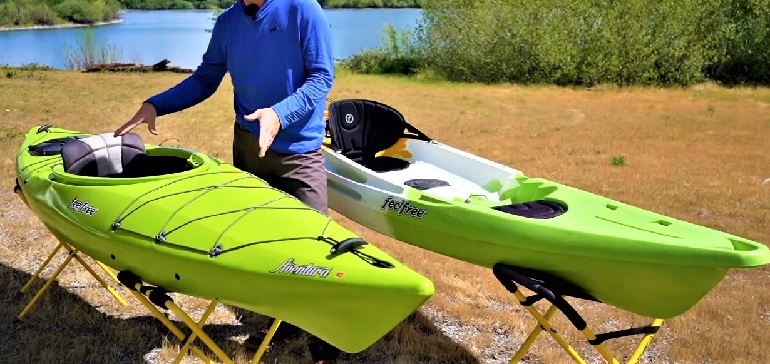
Best sit-on-top kayaks allow for more freedom of movement and easier access for beginners, but a sit-in is a more stable boat—and therefore harder to tip over. You can learn how to kayak more stable.
If possible, try both types so that you can see which one fits your needs best. After you have narrowed down the type, you also need to look for kayaks for beginners that suit your needs.
The next step is picking out where you’ll be going on your first adventure; lakes and ponds provide great opportunities for beginners because they’re not too rough or deep (less than 4 feet), unlike sea kayaking
Once in place, all that remains is getting into your new vessel! This process might seem daunting at first, but once outside on shallow water, it becomes much easier.
Just make sure not to stand up right away since this could put pressure on the boat’s hulls, causing them to buckle under weight rather than float along smoothly as they should.
You Can Learn the Basics of Kayaking in Minutes
While kayaking is not that hard, there is a learning curve. Before you start learning how to kayak, it is important to keep in mind a few things about paddles and how to size a kayak paddle correctly.
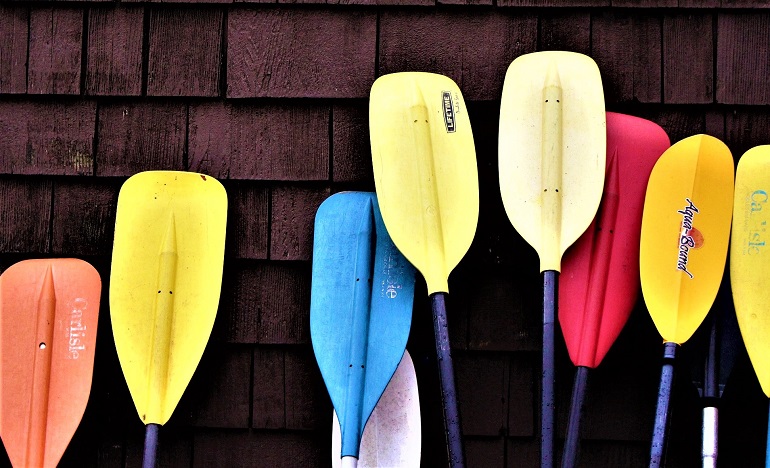
First, there are two types of paddle blades: double-ended and single-ended. While both can be used for either sitting or kneeling positions, only single-ended paddles offer an alternative at different angles (they’re like levers).
If you want to stay upright in your seat and use both hands for steering on choppy waters, this is likely a better option for you. Double-ended paddle blades are designed for faster movements that can help with stability but may not work well when maneuvering through narrow channels or hazards like rocks or submerged logs.
Second, proper body positioning during a paddle stroke is key: You should keep your back straight while bending forward at the waist as much as possible while keeping both elbows bent 90 degrees and fingers pointing forward; this allows maximum leverage with minimal effort needed to move through the shallow water efficiently.
Thirdly (and possibly most importantly), don’t forget about upper body strength—you’ll need it if there’s no one around for assistance!
Kayak Gear and Clothing
Before we get on with the discussion about how to kayak and the essential gear, there are a few rules that you need to take into account as a beginner kayaker. These rules are pretty logical, but I thought that it is important to mention them here as well.
You should always carry a personal flotation device (PFD) when paddling your kayak in open water. You can find PFDs for sale at most outdoor stores or online retailers but ensure to go with a US Coast Guard-approved option appropriate for the body of water you’ll be in.
You also need proper clothing, a kayak bilge water pump to pump excess water, and a spray skirt if you are using a sit-in kayak.
But let’s talk more about the specifics of kayaking gear!
Essential Kayaking Gear
To keep things simple, let’s make a list. When we talk about kayaking, we talk about some basic gear, like:
- Kayak – Sup fishing kayaks, touring kayaks, or recreational kayaks ;
- Paddle blade;
- Life vest;
- Spray skirt;
- Kayaking gloves
- Paddling gloves and/or pogies.
When it comes to kayak, paddle blade, and life vest, things are pretty clear. Paddling gloves or pogies can be a bit confusing, especially for beginners. They are waterproof covers that go over your hands to keep them warm and dry. These can be used in tandem with paddling mitts.
If you have cold hands or don’t like wearing gloves at all, pogies will keep your hands warmer than paddling mitts alone will. You can also use these over fingerless cycling or hiking gloves if you prefer!
They’re also great for added warmth when it’s raining outside since they cover up the entire hand instead of just covering individual fingers, as well as keeping them warm while out on the water.
If there is any part of your body that tends toward getting cold quickly when wet (ears/nose), this is especially important because it keeps those parts from getting painful.
So, you can enjoy your time out on the water without worrying too much about discomfort due to low temperatures later on down the line.
Proper Clothing
Wear a Life Jacket
If you’re out on the water, it’s best to be prepared for any situation. A life vest provides extra buoyancy in case of an accident, so you can stay afloat until help arrives.
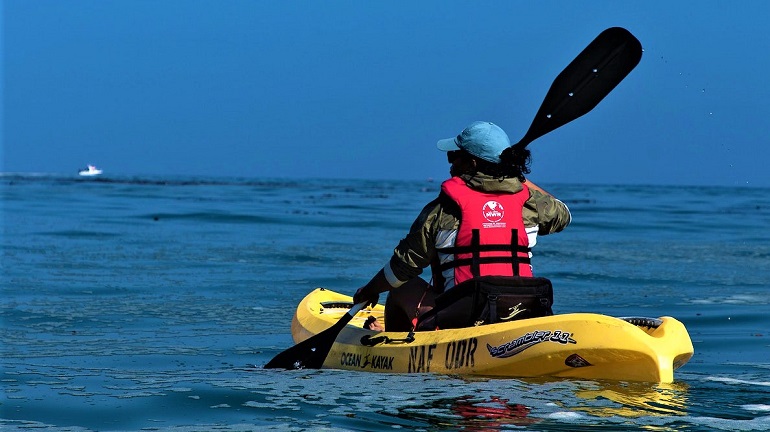
Wear a Hat
Hats are important because they keep your head cool as well as protect it from direct exposure to the sun’s rays (which can lead to premature aging). It also helps keep sweat off of your face while paddling around all day long!
Wearing Shoes That Dry Quickly
Shoes is the key when you go on your kayaking adventure so that your feet don’t get soggy from all the water splashing into them when going over waves.
A pair of water shoes, waterproof hiking boots, or even athletic shoes will work well for this purpose—just make sure they have non-marking soles so they won’t leave any marks behind on the floorboards of your boat. Specific kayaking shoes are now also available on the market.
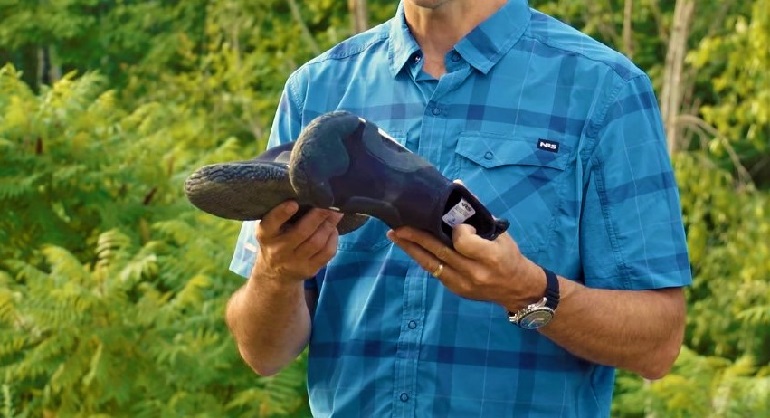
Personal Items
If you are new to kayaking, it’s a good idea to have a day bag with you. This can include items like:
Water Bottle
You will be thirsty on your trip, and your body needs water. If you don’t have one with you, consider carrying at least one Nalgene bottle.
Sunscreen
I recommend using SPF 30 or higher sunscreen and wearing sunglasses when possible for maximum protection against harmful rays. The sun is your friend when it comes to kayaking, but only if you protect yourself from its rays.Sunscreen will keep your skin from burning and prevent future wrinkles and cancer risks by blocking harmful UV rays before they damage your body’s DNA structure.
Bonus: Camera
Take photos of the scenery, wildlife, and people that help make this activity so enjoyable! Make sure to bring extra batteries or film if necessary.
The Basic Kayaking Strokes
There are three types of kayaking strokes: forward strokes, reverse strokes, and sweep strokes. And the rest is pretty simple, as you would think.
The forward stroke is used to propel the kayak straight forward. The reverse stroke propels the kayak backward, and the sweep stroke turns your kayak in a direction perpendicular to its current course, like when you perform a 180-degree turn and head back to where you came from.
In addition to moving forward, back, and turning with these strokes, there are also variations that allow you to move sideways by using your paddle shaft as a rudder, especially in windy conditions.
The Forward Stroke
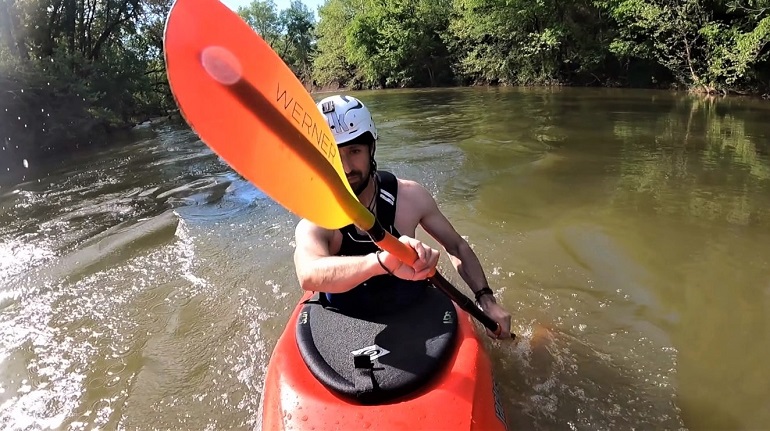
The next step is to learn how to hold the paddle and move it. You can use either a single-bladed or double-bladed paddle, but you’ll probably find that a single blade is more comfortable at first.
Hold it in front of your torso. The top (or leading) edge should be facing up so that when you start paddling forward, the blade will cut through the water on an angle with its leading edge pointed slightly downward.
If this feels awkward and inefficient, try moving your hands closer together or farther apart—find what feels best for how much space you need between them to keep a proper balance as well as how far away from each other they need to be for maximum propulsion power.
Now we’ll go over some important aspects of form: Using your body properly can make all the difference in how quickly and efficiently you move across the water! As mentioned earlier, keeping a good posture will help protect against injury; however, proper alignment helps prevent strain as well.
Make sure your shoulders are relaxed; drop them down away from ears, so they’re parallel with elbows and bent at 90°; relax neck muscles, so your head hangs naturally rather than being pulled upward by shoulder tension.
Keep the core engaged throughout the entire stroke cycle by contracting abdomen muscles (like those around the frontispiece), which connects the upper back & shoulders together while helping the lower back stay straight instead of sinking into an arch.
The Reverse Stroke
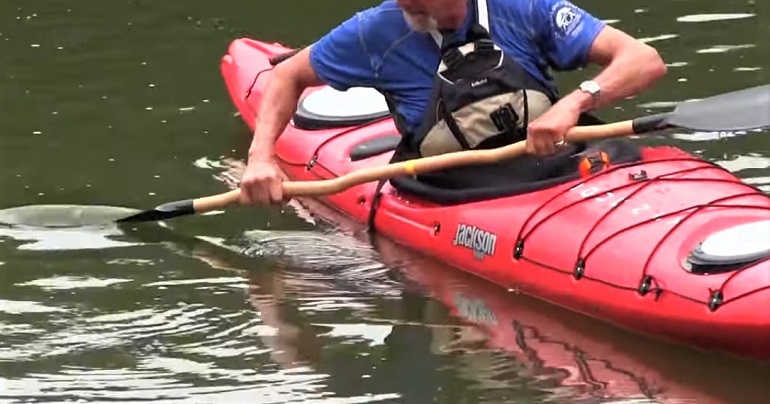
Being the exact opposite of a forward stroke, the reverse stroke is a way to stop your kayak when you need to halt quickly. You can use it to avoid obstacles or other kayakers.
This stroke is also used to turn around and get back on course if you happen to be off track, but only do this if there are no other people around who might get hit by your paddle as you swing it around! If everyone else is paddling on the same side as you, then try using an Eddy turn instead.
The Eddy turn is a way to change direction quickly without having to stop. It’s done by paddling hard against the current, turning your kayak sideways, then rolling onto its side as you pull out of the water with one hand and push off from the other side with both feet. This will give you enough momentum to get moving in a new direction.
To perform a reverse stroke:
- Sit up straight.
- Hold your paddle, and blade in front of you with the end pointing down.
- Slowly pivot the paddle so that the blade is pointing out and down into the water.
- Push the paddle down and away from you as hard as possible while pulling back on it with both hands.
The Sweep Stroke
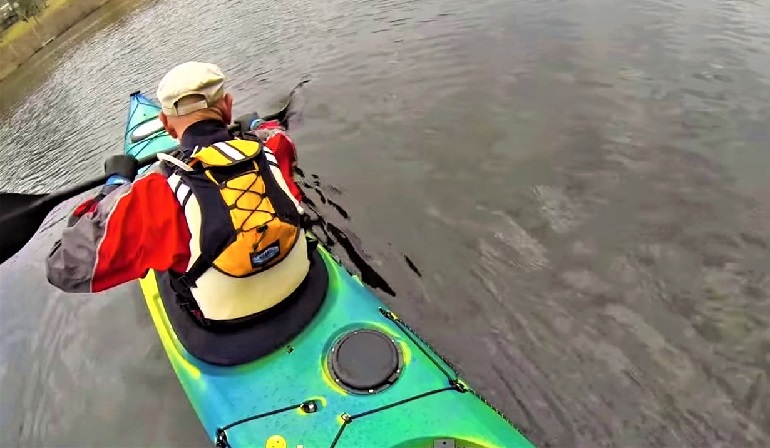
The sweep stroke is a useful skill to have when you need to change direction or steer your kayak in a different direction.
It’s a variation of the forward stroke and is performed by sweeping your paddle from one side to the other while keeping it perpendicular to the water’s surface. This changes both your heading and speed, making it easy for you to turn around or change direction at a moment’s notice.
The sweep stroke is performed by holding your paddle at an angle of about 45 degrees, with the blade pointing slightly upward. Then you push it out and across the water’s surface from one side to the other, keeping it perpendicular to the water’s surface.
The trick here is not to try and cut through the water but rather just push it aside.
The sweep stroke is similar to the forward stroke, but instead of pushing the paddle forward into the water, you pull it back toward your boat. This causes a twist in the water that pushes against the hull and propels it forward.
The key is to exercise, and in time you will improve your paddling technique.
How to Hold Your Kayak Paddle

Your kayak paddle is a tool that you’ll use to propel through the water, so it’s important to hold it correctly. To get started, find a comfortable position for your hands and arms.
You can start by holding the paddle shaft with one hand and resting your other hand on top of that one. Then, place both thumbs on top of the blade (or leading edge) of your paddle and gently rest them there.
Holding the paddle in this way is called “two-handers,” because both hands are working together to move the boat forward while they’re rowing in unison with each other at all times.
It’s also important not to grip too tightly—this could cause fatigue or muscle strain after long periods of paddling—and also not too loosely—you don’t want to lose control over where exactly those blades land when they hit the water!
And finally: don’t go overboard with how high or low you hold them; just make sure they’re somewhere between half-shoulder height and waist level when sitting upright in your seat inside the cockpit.
There are a few different types of two-handed paddles, but the most common ones are those that feature straight blades with no bend in them. You can also find slightly bent-shaft models that offer more power at the expense of maneuverability (plus they’re generally heavier than their straight-bladed counterparts).
Bent-shaft paddles are best for strong, experienced paddlers who need extra power to get where they’re going. Straight-bladed models are usually better for beginners because they’re easier to learn with and less intimidating than their bent-shaft cousins; however, they can be just as effective if used properly.
How to Adjust and Launch Your Kayak
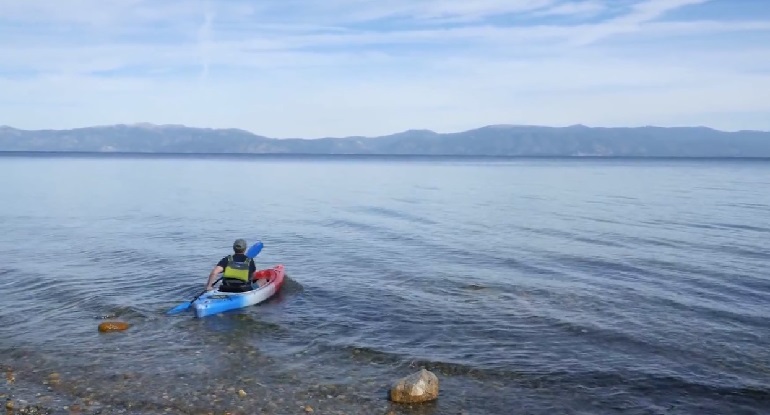
The first step to getting a well-adjusted kayak is to take a look at your paddle and enclosed seat. There should be a knob on the end of each that can be turned clockwise or counterclockwise. Turning these will raise or lower your seat and change how far away from the water surface you are sitting.
Once you’ve found a comfortable position, it’s time to launch. To do this, step into the kayak with your feet positioned at the end of the kayak (your knees should be bent). Then, move forward until you’re sitting on your seat and have one foot on each foot pegs. Now, you’re ready to paddle.
The first thing you’ll want to do is make sure that your paddle is fully extended and in front of you. Once it’s there, take a look at the blade, which has two sides (one long side and one short side). Positioning this properly will help you move forward easily.
Adjusting Your Paddle
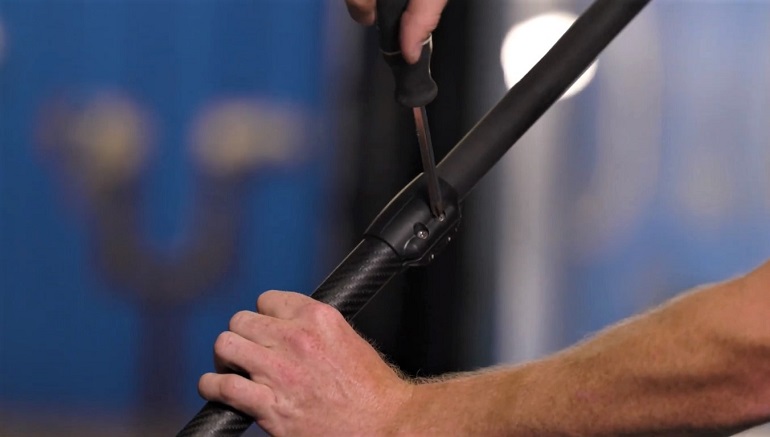
Your kayak paddles may also have adjustable straps so that you can change the kayak paddle length based on how tall you are (or if someone else will be using them). Once you have the correct length, grab the paddle by its handle and pull it back until it’s fully extended in front of you.
The blade should be at a 45-degree angle over your head, with the long side facing to your left (if you are right-handed) or right (if you are left-handed). Then, begin paddling by bringing the blade forward into the water and pushing it down as hard as possible.
Be sure to keep your body still as you do this, so that you can maintain control over your kayak. If you’re starting out for the first time, try to paddle in a straight line for at least ten seconds before stopping.
Once you feel comfortable with this exercise, try turning around by bringing the blade back toward yourself and then pushing forward again.
Safety Precautions and Weather Conditions for Kayaking
In addition to wearing appropriate clothing and footwear, kayakers should ensure wearing a life vest. Though this is less of an issue in warm weather, it’s still recommended that you have one on hand for colder days in case you get into trouble.
Other safety precautions include sunscreen and protective hats or sunglasses if you’re going out during peak hours. You’ll also want to bring dry clothes with you to change into after your trip is over so that you can drive home safely without getting soaked or covered in sand.
Most importantly, DO NOT GO KAYAKING IF YOU CAN’T SWIM. I don’t care how experienced or skilled at paddling someone thinks they are—there is no substitute for being able to swim if something goes wrong when out on the water.
If you’re new to kayaking, try taking a class or going out with an experienced friend before heading out on your own. You’ll learn the basics of paddling and safety, plus get some practice in—which is always a good thing.
You should also be sure to check the weather forecast before you go kayaking. This will help you determine whether or not it’s safe to go out on the water and how long you’ll be able to stay out there before having to return home.
If you’re unsure about whether or not it’s safe to go out on the water, check with your local weather service. If they say a storm is coming and it could be dangerous, then wait until the storm passes before going out on your kayak. It would be a good thing to also know the water temperature.
Tips for Your First-time Kayaking
Let’s summarize! Before you head out on the water, it’s important to make sure you have everything you need to enjoy your time. Here are some beginner kayaking tips that will help:
Sunscreen
the sun can be intense when you’re in the middle of a lake. Make sure to wear sunscreen and a cover-up.
Life Jackets
Kayak life jackets are required by law, so don’t forget yours! They’re also important safety gear that can save your life if something goes wrong while kayaking. Always keep in mind the safety tips.
Hat
a wide-brimmed hat is best for keeping the sun out of your eyes and protecting your face from windburn. It’s worth investing in one that’s waterproof if possible; this way it’ll stay dry when it rains too!
Sunglasses
don’t forget these! Not only do sunglasses help protect against the glare of the water, but they also keep UV rays out of people’s eyes (and make them look super cool, but that’s just a bonus).
Conclusion
Kayaking is a great way to spend time outdoors and enjoy the scenery. It’s also a fun activity for friends and family members of all ages. You can also burn calories kayaking, so it’s practically a win-win.
Whether you’re looking for an adventure or just want some exercise to improve your kayaking skills, I hope this article will help you get started.
With the right kayaking equipment, it’s easy to begin your adventures and have fun. Don’t forget about the transportation. You can learn how to tie your kayak to roof racks or even transport your 2 kayaks without a roof rack.
0 Comments